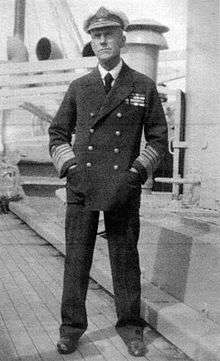Lewis Bayly (Royal Navy officer)
| Sir Lewis Bayly | |
|---|---|
 Admiral Sir Lewis Bayly, 1915 | |
| Born | 28 September 1857 |
| Died | 16 May 1938 (aged 80) |
| Allegiance |
|
| Service/branch |
|
| Rank | Admiral |
| Commands held |
1st Battle Cruiser Squadron 3rd Battle Squadron 1st Battle Squadron Channel Fleet Royal Naval College, Greenwich Commander-in-Chief, Coast of Ireland Station |
| Battles/wars | First World War |
| Awards |
Knight Commander of the Order of the Bath Knight Commander of the Order of St Michael and St George Commander of the Royal Victorian Order Grand Cross of the Order of the Dannebrog |
Admiral Sir Lewis Bayly, KCB, KCMG, CVO (28 September 1857 – 16 May 1938) was a Royal Navy officer who served during the First World War.
Biography
Early life
Bayly was born at Woolwich on 28 September 1857. He was a greatgreatnephew of Admiral Keats. Bayly joined the Royal Navy in 1870. He served in the Third Anglo-Ashanti War (1873) and against pirates in the Congo basin (1875). He later served on HMS Agincourt and in the Anglo-Egyptian War (1882). Bayly married in 1892 Yves Henrietta Stella, daughter of Henry Annesley Voysey; there was no issue of the marriage.
In July 1902, Bayly was appointed in command of the protected cruiser HMS Talbot, serving at the China station.[1] He was given command of the destroyers of the Home Fleet in HMS Attentive (1907–1908). On 22 March 1908, Bayly was appointed a Naval Aide-de-Camp to King Edward VII. He was then given a shore command as President of the Royal Naval War College (1908–1911). Before the outbreak of the war he was given command of the 1st Battle Cruiser Squadron (1911–1912) and of the 3rd Battle Squadron (1913–1914).
First World War
During the early months of the First World War he commanded the 1st Battle Squadron and was in command of the rescue operation when the modern battleship HMS Audacious was mined and sunk in October 1914. In December 1914 he was appointed to command the Channel Fleet flying his flag in HMS Lord Nelson.
Under the command of Bayly, the 5th Battle Squadron spent 31 December participating in gunnery exercises off the Isle of Portland, supported by the Topaze class light cruisers HMS Topaze and HMS Diamond. After the exercises, that night the fleet remained at sea on patrol even though submarine activity had been reported in the area. With rough sea conditions and the wind increasing, submarine attacks would have been difficult to carry out effectively and so were not thought to be a significant threat. Nonetheless the pre-dreadnought battleship HMS Formidable was hit and sunk by SM U-24. Bayly was later criticized for not taking proper precautions during the exercises, but was cleared of the charge of negligence.
In January 1915 he was made President of the Royal Naval College, Greenwich. In July 1916 he was made Senior Officer on the Coast of Ireland, (later the title became Commander-in-Chief, Coast of Ireland). He held this post at Queenstown until 1919. In this function Bayly was tasked with keeping the approaches to Britain safe from U-boats attacks. In 1917, Bayly, promoted to admiral, was given command of a mixed British-American force defending the Western approaches. He took as his chief-of-staff the American captain Joel R. P. Pringle. Bayly had a good working relation with his U.S. counterpart William Sims.[2]
Admiral Bayly retired in 1919. He died in London in 1938.
Honours and awards
- Knight Commander of the Order of the Bath
- Knight Commander of the Order of St Michael and St George
- Commander of the Royal Victorian Order
- Grand Cross of the Order of the Dannebrog (Denmark)
- Commander of the Legion of Honour (France)
- Distinguished Service Medal (United States)
Notes
- ↑ "Naval & Military intelligence". The Times (36820). London. 15 July 1902. p. 11.
- ↑ See 'Castles of Steel.'
References
- BAYLY, Lewis, Pull together: The memoirs of Admiral Sir Lewis Bayly, G G Harrap & Co, London, 1939
External links
| Military offices | ||
|---|---|---|
| Preceded by Sir Alexander Bethell |
President, Royal Naval College, Greenwich 1915 |
Succeeded by Sir Henry Jackson |
| Preceded by Sir Charles Coke |
Commander-in-Chief, Coast of Ireland Station 1915–1919 |
Succeeded by Sir Reginald Tupper |